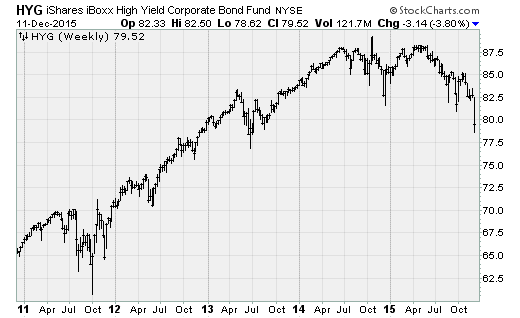Wall Street gets clobbered on every side
U.S. equities were slammed lower on Friday, suffering the worst one-day decline for large-cap stocks since September after investors reacted to ongoing declines in crude oil and high-yield bonds.
Treasury bonds rallied, breaking out of a trading range going back to August, as fears grow that the Federal Reserve could be on the verge of a policy mistake next week: the first rate hike since 2006 amid recent slowdowns in U.S. factory activity and other economic measures. Adding to the pressure were big declines in popular big-tech momentum favorites such as Amazon (AMZN) and Facebook (FB).
The Dow Jones industrials lost 1.8 percent, or nearly 310 points. The S&P 500 dropped 2 percent, and the Nasdaq Composite lost 2.2 percent. For the year, the Dow is now down 3.1 percent.
The dollar weakened, gold gained 0.4 percent and oil fell 3.5 percent to $35.47 a barrel -- returning to 2008-2009 lows -- and down 11.3 percent for the week. Oil prices continue to wilt in the wake of last Friday's decision by OPEC to hold production near current levels of around 31.5 million barrels per day.
Today, oil inventory concerns were in the forefront after the International Energy Agency said the global supply surplus could persist until at least late 2016 as Iranian crude comes back into the market. It also highlighted OPEC's "renewed determination" to squeeze weaker, high-cost non-OPEC producers in a bid to regain market share from U.S. shale producers.
Corporate credit was hit after Third Avenue Management's junk-bond fund barred investor withdrawals while it liquidates -- attracting attention to the long simmering problem of ultralow trading volumes in many areas of the corporate bond market after years of near-zero interest rates from the Fed.
Third Avenue management highlighted difficult market conditions, made worse by hedge fund short positions, making it nearly impossible to raise cash to meet client redemption requests without liquidating positions at fire-sale prices. Reuters reported that at least one-fifth of the fund's assets were in illiquid positions.
As a result, the iShares High Yield Corporate Bond Fund (HYG) fell to levels not seen since 2013 (chart above) and suffered a 3.8 percent decline for the week, its worst performance since 2011.
Many have been dismissive of these bond liquidity fears, which I started writing about more than a year ago. Vanguard's global head of fixed income Greg Davis said concerns were "a bit overblown" just a few months ago. Friday's sell-off proves these fears were well founded.
All of this further raises the stakes for next week's Federal Reserve policy decision because the start of a monetary tightening campaign will only further encourage investors to sell high-yield bond positions on yield sensitivity and rising default risks in the energy sector amid fresh declines in crude oil.
Already, according to FactSet, S&P 500 energy sector earnings are expected to decline a whopping 65 percent decline in the fourth quarter over last year.
No surprise then that energy stocks led the Friday decliners, falling 3.4 percent as a group followed by material stocks, which dropped 2.7 percent. Exxon Mobil (XOM) lost 1.8 percent, while Chevron (CVX) dropped 3.2 percent.
Friday's large-cap breakdown only confirmed weeks of warning from areas like transportation stocks, small-cap stocks, utility stocks, commodities, and credit. All of which have been weakening while the Dow held near the 18,000 level. It also confirmed technical signs that something was amiss, such as oddly weak market breadth measures as fewer and fewer stocks held the major averages aloft.
That's all changing now, as investors realize the end of the Fed's zero percent interest rate policy might not be as benign as they hoped.

